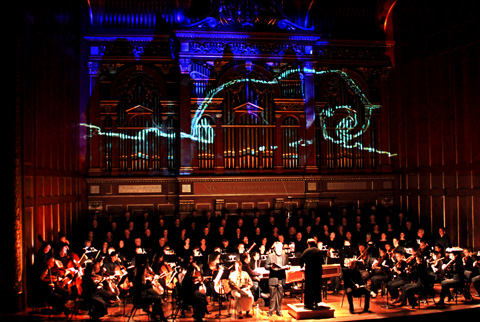
NICE PICTURES The images in this video-accompanied Creation were occasionally charming, but the absence of a printed text created its own distraction. |
Haydn cared about words. One of his late marvels, The Creation, his oratorio based on the Genesis story (from both the Bible and Paradise Lost), was inspired by Handel's English oratorios. Haydn published the libretto in both German and singable English, which we occasionally get in this country, though 18th-century diction and syntax ("with verdure clad the fields appear") pose challenges for both singers and audience. Listeners need all the help they can get.
Betsy Burleigh led Chorus pro Musica in a stirring and elegant, lilting and expansive performance, with members of the Boston Philharmonic Orchestra (the magical oboist Peggy Pearson, and the two violin sections seated antiphonally), and three unusually well-matched vocal soloists: bright and vibrant soprano Mary Wilson, firm-voiced tenor Zachary Wilder, and resonant bass-baritone Paul Guttry as three angels singing God's praises, with Wilson and Guttry doubling as the touchingly devoted Eve and Adam.
The two men were especially good at getting the words across (at least the consonants), especially in their lightly accompanied recitatives, though the full orchestra tended to drown out verbal subtleties. The chorus delivered maybe a quarter of the words — not the worst average, as these things go. Overall, the diction was good enough for anyone to follow the words on the page.
But Burleigh decided not to include the words in the program.
In an effort to attract a younger, more visually-oriented audience, with the encouragement of Chorus pro Musica tenor and board member David McCue, McCue's nephew Joss Sessions, a 22-year-old Yorkshire video artist who told the Globe that he had never before listened seriously to classical music, was invited to create a series of video projections, which he would "perform" live, during the concert (and for which he refused remuneration). In a necessarily darkened Jordan Hall, to keep the audience focused on the videos rather than on reading, there would be no text. "There were times," Burleigh alerted us from the stage to the occasional absence of video, "when it made no sense to have the visuals distracting from the words." But the absence of words created its own distraction.
Even had the videos been dazzling, losing the text would be a high price to pay. How better in this piece to involve — to grab — an audience than to have them follow and engage with the words Haydn was setting? Sessions's images were occasionally charming but they were also pretty predicable. The first choral outburst, "Let there be light," had shafts of light followed by a kaleidoscopic sunburst. We got raindrops, snowflakes, and "boisterous" waves. The images for Haydn's enchantingly musicalized birds and animals, down to the lowly worm, were more cartoon-like and literal, flying, trotting, galloping, and crawling across the organ pipes at the back of Jordan Hall's stage. (But why were they were all moving only from left to right? Why were Eden's animals all heading in the same direction, as if to Noah's ark?) Two key projections were less successful. Why was the "verdurous" pastoral landscape projected in red, white, and blue? Worse, the noblest of God's creatures, Adam and Eve, were flat, motionless, and inexpressive (and because they were projected against the organ pipes, they looked as if they were wearing striped pajamas). What did this add? Still, at the end, Sessions got an enthusiastic hand.